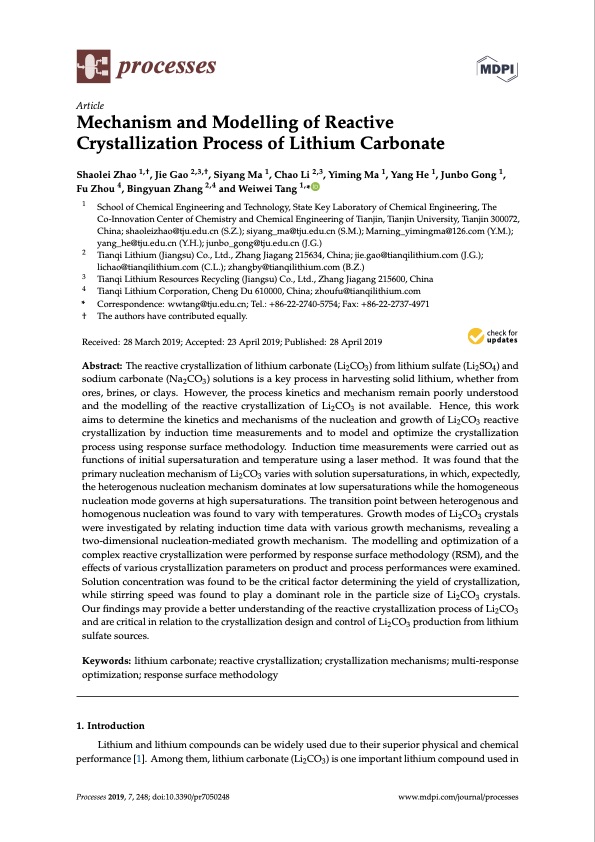
PDF Publication Title:
Text from PDF Page: 001
processes Article Mechanism and Modelling of Reactive Crystallization Process of Lithium Carbonate Shaolei Zhao 1,†, Jie Gao 2,3,†, Siyang Ma 1, Chao Li 2,3, Yiming Ma 1, Yang He 1, Junbo Gong 1, Fu Zhou 4, Bingyuan Zhang 2,4 and Weiwei Tang 1,* 1 2 3 4 * Correspondence: wwtang@tju.edu.cn; Tel.: +86-22-2740-5754; Fax: +86-22-2737-4971 † The authors have contributed equally. Received: 28 March 2019; Accepted: 23 April 2019; Published: 28 April 2019 School of Chemical Engineering and Technology, State Key Laboratory of Chemical Engineering, The Co-Innovation Center of Chemistry and Chemical Engineering of Tianjin, Tianjin University, Tianjin 300072, China; shaoleizhao@tju.edu.cn (S.Z.); siyang_ma@tju.edu.cn (S.M.); Marning_yimingma@126.com (Y.M.); yang_he@tju.edu.cn (Y.H.); junbo_gong@tju.edu.cn (J.G.) Tianqi Lithium (Jiangsu) Co., Ltd., Zhang Jiagang 215634, China; jie.gao@tianqilithium.com (J.G.); lichao@tianqilithium.com (C.L.); zhangby@tianqilithium.com (B.Z.) Tianqi Lithium Resources Recycling (Jiangsu) Co., Ltd., Zhang Jiagang 215600, China Tianqi Lithium Corporation, Cheng Du 610000, China; zhoufu@tianqilithium.com Abstract: The reactive crystallization of lithium carbonate (Li2CO3) from lithium sulfate (Li2SO4) and sodium carbonate (Na2CO3) solutions is a key process in harvesting solid lithium, whether from ores, brines, or clays. However, the process kinetics and mechanism remain poorly understood and the modelling of the reactive crystallization of Li2CO3 is not available. Hence, this work aims to determine the kinetics and mechanisms of the nucleation and growth of Li2CO3 reactive crystallization by induction time measurements and to model and optimize the crystallization process using response surface methodology. Induction time measurements were carried out as functions of initial supersaturation and temperature using a laser method. It was found that the primary nucleation mechanism of Li2CO3 varies with solution supersaturations, in which, expectedly, the heterogenous nucleation mechanism dominates at low supersaturations while the homogeneous nucleation mode governs at high supersaturations. The transition point between heterogenous and homogenous nucleation was found to vary with temperatures. Growth modes of Li2CO3 crystals were investigated by relating induction time data with various growth mechanisms, revealing a two-dimensional nucleation-mediated growth mechanism. The modelling and optimization of a complex reactive crystallization were performed by response surface methodology (RSM), and the effects of various crystallization parameters on product and process performances were examined. Solution concentration was found to be the critical factor determining the yield of crystallization, while stirring speed was found to play a dominant role in the particle size of Li2CO3 crystals. Our findings may provide a better understanding of the reactive crystallization process of Li2CO3 and are critical in relation to the crystallization design and control of Li2CO3 production from lithium sulfate sources. Keywords: lithium carbonate; reactive crystallization; crystallization mechanisms; multi-response optimization; response surface methodology 1. Introduction Lithium and lithium compounds can be widely used due to their superior physical and chemical performance [1]. Among them, lithium carbonate (Li2CO3) is one important lithium compound used in Processes 2019, 7, 248; doi:10.3390/pr7050248 www.mdpi.com/journal/processesPDF Image | Reactive Crystallization Process of Lithium Carbonate

PDF Search Title:
Reactive Crystallization Process of Lithium CarbonateOriginal File Name Searched:
processes-07-00248-v2.pdfDIY PDF Search: Google It | Yahoo | Bing
Product and Development Focus for Infinity Turbine
ORC Waste Heat Turbine and ORC System Build Plans: All turbine plans are $10,000 each. This allows you to build a system and then consider licensing for production after you have completed and tested a unit.Redox Flow Battery Technology: With the advent of the new USA tax credits for producing and selling batteries ($35/kW) we are focussing on a simple flow battery using shipping containers as the modular electrolyte storage units with tax credits up to $140,000 per system. Our main focus is on the salt battery. This battery can be used for both thermal and electrical storage applications. We call it the Cogeneration Battery or Cogen Battery. One project is converting salt (brine) based water conditioners to simultaneously produce power. In addition, there are many opportunities to extract Lithium from brine (salt lakes, groundwater, and producer water).Salt water or brine are huge sources for lithium. Most of the worlds lithium is acquired from a brine source. It's even in seawater in a low concentration. Brine is also a byproduct of huge powerplants, which can now use that as an electrolyte and a huge flow battery (which allows storage at the source).We welcome any business and equipment inquiries, as well as licensing our turbines for manufacturing.| CONTACT TEL: 608-238-6001 Email: greg@infinityturbine.com | RSS | AMP |